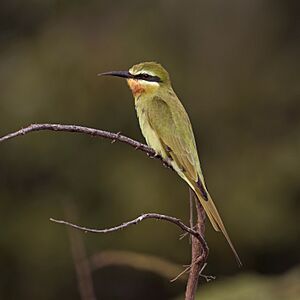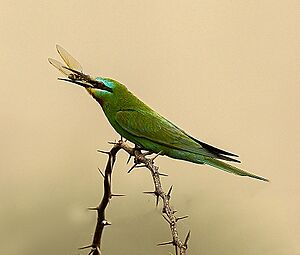Blue-cheeked bee-eater facts for kids
Quick facts for kids Blue-cheeked bee-eater |
|
|---|---|
 |
|
| M. p. persicus, Namibia | |
 |
|
| M. p. chrysocercus, Senegal | |
| Conservation status | |
| Scientific classification |
The blue-cheeked bee-eater (Merops persicus) is a beautiful bird known for eating insects. It belongs to the bee-eater family, called Meropidae. The name Merops comes from an old Greek word for "bee-eater". The word persicus is Latin for "Persian". This name tells us where these birds were first found.
These birds breed, or have their babies, in North Africa and the Middle East. Their breeding areas stretch from eastern Turkey all the way to Kazakhstan and India. Most blue-cheeked bee-eaters are strong migratory birds. This means they travel long distances. They fly to tropical Africa for the winter months. Some groups, however, live in the Sahel region all year round. Sometimes, a few of these birds fly far from their usual homes. They are rarely seen north of their breeding areas. Most of these rare sightings happen in Italy and Greece. In 2024, one was even seen in Sri Lanka for the first time!
Contents
Different Kinds of Blue-cheeked Bee-eaters
Scientists recognize two main types, or subspecies, of the blue-cheeked bee-eater:
- Merops persicus persicus - This type breeds in Asia. It spends its winters in East and Southern Africa.
- Merops persicus chrysocercus - This type breeds in North Africa. It travels to West Africa for the winter.
These bee-eaters are quite similar to other bee-eater species. They are closely related to the blue-tailed bee-eater and the olive bee-eater.
What the Blue-cheeked Bee-eater Looks Like
Like other bee-eaters, this bird is very colorful and has a slim body. Its feathers are mostly green. It has bright blue patches on its face. A black stripe goes across its eyes. Its throat is a mix of yellow and brown. The bird's beak is black.
Blue-cheeked bee-eaters can grow to be about 31 centimeters (12 inches) long. Their two long central tail feathers add another 7 centimeters (3 inches) to their length. Male and female birds look very much alike. However, the female's tail feathers are a bit shorter.
Where They Live and What They Eat
These birds like to breed in warm, dry areas. They prefer places with some trees, like acacia trees. In winter, they live in open woodlands or grasslands. As their name suggests, bee-eaters mainly eat insects. They especially love bees, wasps, and hornets. They catch these insects in the air. They often fly out from a perch, like a branch or a telephone wire. Blue-cheeked bee-eaters probably eat more dragonflies than any other insect. Telephone wires are a favorite spot for them to hunt from.
Nesting Habits
Blue-cheeked bee-eaters might nest alone. They can also nest in small groups called colonies. These colonies can have up to ten birds. Sometimes, they even nest in colonies with European bee-eaters. Their nests are usually in sandy banks or low cliffs. They also nest on the shore of the Caspian Sea.
They dig a long tunnel for their nest. This tunnel can be from 1 to 3 meters (3 to 10 feet) long. Inside the tunnel, the female lays four to eight eggs. The eggs are usually six or seven, and they are round and white. Both the male and female bird help take care of the eggs. But only the female sits on the eggs at night. The eggs hatch after about 23 to 26 days.
Its Call
The call of the blue-cheeked bee-eater sounds a bit "flatter" than the call of the European bee-eater. It is not as "fluty."




